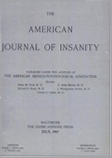A COMPARATIVE STUDY OF HYPOGLYCEMIC SHOCK TREATMENT AND CONTROL OBSERVATION IN SCHIZOPHRENIA
Abstract
A group of 100 patients of the predominantly chronic type of schizophrenia, equally divided by sex, underwent a course of hypoglycemic shock treatment while 69 patients—36 men and 33 women—were observed as controls. Fifteen other patients, eight men and seven women have improved spontaneously while in preparation for treatment. The report is based on the state of the patients eight months to two years after termination of treatment or control observation.
Various degrees of improvement took place in 36 per cent of the treated patients, a lower percentage than generally reported.
The percentage of improvement in the control group was 21.7.
The percentage of improvement in the combined control and spontaneously improved group was 35.7 or about the same as in the treated group.
Relapses took place in 47 per cent of the treated patients, in 33.3 per cent of control cases and in 24 per cent of the combined control and spontaneously improved patients.
The treatment was the cause of death in 3 per cent of cases.
"Recovery" occurred in only slightly over 7 per cent among treated patients with psychosis of not more than 18 months' duration.
The same rate of "recovery" took place among the combined control and spontaneously improved patients with psychosis of less than si months' duration.
The percentage of "improved" ranged from 75.0 to 21.5 in the treated group, from 75.0 to 8.8 in the control group and from 57.0 to 12.2 in the combined control and spontaneously improved group, in proportion to the duration of the psychosis.
"Lack of improvement" ranged from 12.5 per cent to 78.5 per cent in the treated group, from 25.0 per cent to 86.8 per cent in the control group and from 7.2 per cent to 79.7 per cent in the combined control and spontaneously improved group, in proportion to the duration of the psychosis.
The duration of the psychosis in the improved treated, improved control and in the spontaneously improved patients was shorter than in the unimproved patients.
The highest percentage of relapses occurred among patients with psychosis of longer duration.
Both treated and control patients with psychosis of shorter duration had the longest lasting remissions.
Access content
To read the fulltext, please use one of the options below to sign in or purchase access.- Personal login
- Institutional Login
- Sign in via OpenAthens
- Register for access
-
Please login/register if you wish to pair your device and check access availability.
Not a subscriber?
PsychiatryOnline subscription options offer access to the DSM-5 library, books, journals, CME, and patient resources. This all-in-one virtual library provides psychiatrists and mental health professionals with key resources for diagnosis, treatment, research, and professional development.
Need more help? PsychiatryOnline Customer Service may be reached by emailing [email protected] or by calling 800-368-5777 (in the U.S.) or 703-907-7322 (outside the U.S.).



